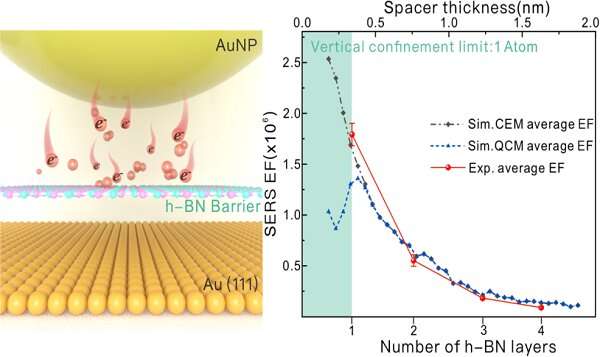
A research team led by Prof. Yang Liangbao from Hefei Institutes of Physical Science, Chinese Academy of Sciences found that hexagonal boron nitride (h-BN) could effectively block electron tunneling and extend the ultimate plasmonic enhancement limits in a single-atom-layer gap, providing deep insights into quantum mechanical effects in plasmonic systems and enabling potential novel applications based on quantum plasmonics. The results were published in Nano Letters.
The team have been working on developing surface-enhanced Raman spectroscopy (SERS) detection methods for years and found that the near-field intensity distribution in the nanometer scale is uneven. To achieve greater electromagnetic enhancement, they used adjacent metal nano-gaps but noticed that reducing their size leads to the emergence of quantum tunneling effect, making it disadvantageous for SERS detection.
To overcome this, the team introduced a high tunneling barrier formed by monolayer h-BN, actively blocking the electron tunneling effect. They quantitatively detected the final near-field enhancement limit in the classical framework by detecting the intrinsic SERS intensity of h-BN in a single particle cavity.
The study proved that monolayer h-BN blocks the electron tunneling using hot electron tunneling quantum computation and layer-dependent scattering spectrum experiments. By comparing the experimental results with the calculated results of the classical electromagnetic model and the quantum correction model, the team realized the final near-field enhancement limit detection within the classical framework.
This work provides important guidance for quantum plasmology and nano-gap photodynamics, helping to further analyze quantum mechanical effects in plasma enhancement.
More information:
Siyu Chen et al, Extending Plasmonic Enhancement Limit with Blocked Electron Tunneling by Monolayer Hexagonal Boron Nitride, Nano Letters (2023). DOI: 10.1021/acs.nanolett.3c00404
Journal information:Nano Letters
Provided by
Chinese Academy of Sciences

READ MORE
Sorry, Tiger Dudes: Your Ladies Are Faking It
Expanding human populations in India have pushed tigers into small, isolated habitats—and resulted in some [...]
Betting on Designer Genes
Gene therapy Wikimedia Commons Some of the most serious medical problems are caused by genes [...]
NASA Snags Its First Asteroid Sample
This artist’s rendering shows the OSIRIS-REx spacecraft descending towards asteroid Bennu to collect a sample. [...]
The One Use of Drones Everyone Can Agree on, Except for Poachers
A Falcon UAV unpiloted aircraft is bungee launched in a midday demonstration flight. © Helge [...]
These Grapes Really Do Taste Like Cotton Candy
If you closed your eyes and popped one of these grapes in your mouth, you’d [...]
Controllable functional ferroelectric domain walls under piezoresponse microscope
Domain patterns after (a) 3.4 V and (b) 5.8 V poling. Dark, white, light gray, [...]
Rising Again
The leaden sky above Big Sur looks as uninviting as cold oatmeal, the temperature is [...]
A machine learning-based approach to discover nanocomposite films for biodegradable plastic alternatives
Comparative display of traditional plastic items and their eco-friendly, biodegradable counterparts developed through predictive modeling. [...]